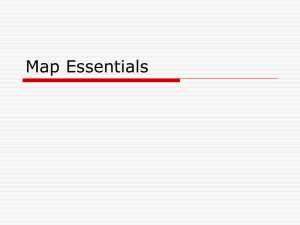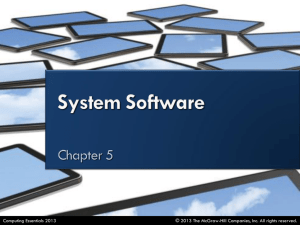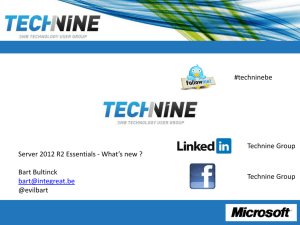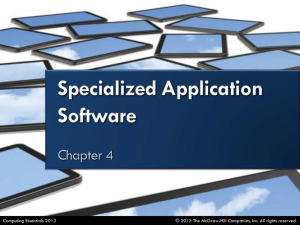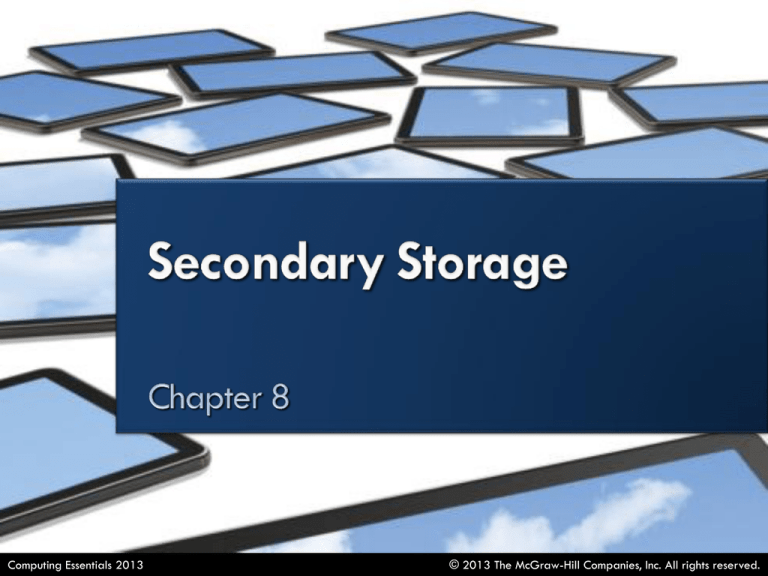
Secondary Storage
Computing Essentials 2013
© 2013 The McGraw-Hill Companies, Inc. All rights reserved.
Secondary Storage
Distinguish between primary and secondary storage.
Discuss the important characteristics of secondary
storage, including media, capacity, storage devices,
and access speed.
Describe hard disk platters, tracks, sectors, and head
crashes.
Compare internal and external hard drives.
Discuss performance enhancements including
disk caching, RAID, file compression, and
file decompression.
8-2
Computing Essentials 2013
© 2013 The McGraw-Hill Companies, Inc. All rights reserved.
Secondary Storage
Define optical storage including compact,
digital versatile, and high-definition discs.
Define solid-state storage, including solid-state
drives, flash memory, and USB drives.
Define cloud storage and cloud storage
services.
Discuss mass storage devices, enterprise
storage systems, and storage area networks.
8-3
Computing Essentials 2013
© 2013 The McGraw-Hill Companies, Inc. All rights reserved.
Secondary Storage
Data storage has expanded from text and
numeric files to include digital music files,
photographic files, video files, and much more.
These new types of files require secondary
storage devices with much greater capacity.
In this chapter, you learn about
the many types of secondary
storage devices including their
capabilities and limitations.
8-4
Computing Essentials 2013
© 2013 The McGraw-Hill Companies, Inc. All rights reserved.
Secondary Storage
Primary storage
Volatile storage
Temporary storage
Random Access Memory
(RAM)
Secondary storage
Nonvolatile storage
Permanent storage
Secondary storage
characteristics
Media
Capacity
Storage devices
Access speed
8-5
Computing Essentials 2013
© 2013 The McGraw-Hill Companies, Inc. All rights reserved.
Secondary Storage
Provides permanent or
nonvolatile storage
Data and programs can be
retained after the computer has
been shut off
Most desktop microcomputer
systems have both hard and
optical disk drives
8-6
Computing Essentials 2013
© 2013 The McGraw-Hill Companies, Inc. All rights reserved.
Secondary Storage
Use rigid, metallic platters that are stacked
one on top of one another
Store and organize files using tracks, sectors,
and cylinders
Large capacity (terabytes)
Susceptible to head crash
Two types of hard disks:
Internal Hard Disk
External Hard Disks
Performance enhancements
8-7
Computing Essentials 2013
© 2013 The McGraw-Hill Companies, Inc. All rights reserved.
Secondary Storage
Hold over 100 gigabytes (GB) of data
Attributes
Lands
Pits
Three types
Compact Disc (CD)
Digital Versatile Disc (DVD)
Blu-Ray (Hi-Def) Disc
8-12
Computing Essentials 2013
© 2013 The McGraw-Hill Companies, Inc. All rights reserved.
Secondary Storage
Solid–state drives (SSDs)
No moving parts
Faster and more durable
than hard disks
Flash memory cards
Widely used in computers, cameras, and portable
devices such as mobile phones and GPS navigation
systems
USB Drives (or Flash Drives)
Connect to USB port
Capacity of 1 GB to 256 GB
8-16
Computing Essentials 2013
© 2013 The McGraw-Hill Companies, Inc. All rights reserved.
Secondary Storage
Cloud computing is where the Internet
acts as a “cloud” of servers
Applications provided as a service rather than a
product
Supplied by servers
Google Apps
Mint.com
8-17
Computing Essentials 2013
© 2013 The McGraw-Hill Companies, Inc. All rights reserved.
Secondary Storage
8-18
Computing Essentials 2013
© 2013 The McGraw-Hill Companies, Inc. All rights reserved.
Secondary Storage
Using a cloud storage service
makes it easy to upload and
share files with
anyone.
8-19
Computing Essentials 2013
© 2013 The McGraw-Hill Companies, Inc. All rights reserved.
Secondary Storage
Large amounts of secondary storage called
mass storage
An enterprise storage system strategy ensures
efficient and safe use of data across an
organizational network Devices include:
File servers
Networked attached storage (NAS)
RAID systems
Tape libraries
Organizational cloud storage
8-20
Computing Essentials 2013
© 2013 The McGraw-Hill Companies, Inc. All rights reserved.
Secondary Storage
8-21
Computing Essentials 2013
© 2013 The McGraw-Hill Companies, Inc. All rights reserved.
Secondary Storage
Architecture to link remote computer storage
devices, such as enterprise storage systems, to
computers such that the devices are available
as locally attached drives
User’s computer provides file system, but SAN
provides disk space
House data in remote locations and still allow
efficient and secure access
8-22
Computing Essentials 2013
© 2013 The McGraw-Hill Companies, Inc. All rights reserved.
Secondary Storage
Software engineers analyze users’ needs and
create application software
General employer requirements
Bachelors degree in
computer science
Extensive knowledge of
computers and technology
Communication and analytical skills
Annual salary of $63,000 to $98,500
8-23
Computing Essentials 2013
© 2013 The McGraw-Hill Companies, Inc. All rights reserved.
Secondary Storage
Future secondary storage disks will eventually
store terabytes (TB) or petabytes (PB)
Your entire life captured in
digital video on a single disc
Currently developing programs
that can scan photos and videos
for a particular person’s face
8-24
Computing Essentials 2013
© 2013 The McGraw-Hill Companies, Inc. All rights reserved.
Secondary Storage
Compare primary storage and secondary storage
and discuss the most important characteristics of
secondary storage.
Discus hard disks including density, platters, tracks,
sectors, cylinders, head crashes, internal, external,
and performance enhancements.
Discuss optical disks including pits, lands, CDs,
DVDs, Blu-ray, and hi def.
8-25
Computing Essentials 2013
© 2013 The McGraw-Hill Companies, Inc. All rights reserved.
Secondary Storage
Discuss solid-state storage including solid-state
drives, flash memory, and USB drives.
Discuss cloud computing and cloud storage.
Describe mass storage devices including
enterprise storages systems, file servers, network
attached storage, RAID systems, tape libraries,
organizational cloud storage, and storage area
network systems.
8-26
Computing Essentials 2013
© 2013 The McGraw-Hill Companies, Inc. All rights reserved.


